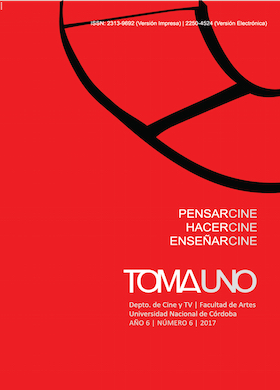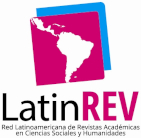Looking and Listening. Haptic Perception and Sensorial Narrative in Gustavo Fontán’s El limonero real
DOI:
https://doi.org/10.55442/tomauno.n6.2018.20902Keywords:
Gustavo Fontán, Juan José Saer, Literature and Cinema, Haptic DimensionAbstract
This article analyzes the modes in which Gustavo Fontán’s El limonero real (2016) departs from a fluvial literary tradition but manages to paint the Paraná river by exploring the relationships between subject and landscape through the sensorial dimensions of cinema. El limonero real propose a perceptive and aesthetic intensification in order to find a new sense of experience that allows redrawing the affective geography of the Argentine coastline. In this sensorial and affective exploration of the real, the film focuses on a haptic visuality, more tactile than optical, as well as on a haptic listening (Marks, 2000, Bruno, 2010). This creates an ambiguous visual and sound perception that allows, thus, to redefine the perceptive experiences of the literary sources that inspired Fontán’s filmic project.
Downloads
References
Andermann, J. (2011). “Paisaje: imagen, entorno, ensamble”, en Geografías culturales: aproximaciones, intersecciones y desafíos, Ed. Perla Zusman, Rogério Haesbaert y Hortensia Castro, 277-90. Buenos Aires: Eudeba.
Biedma, S. (2016). “Al otro lado del río”, en Suplemento Radar, Página12, 28 de agosto de 2016. Disponible en: https://www.pagina12.com.ar/diario/suplementos/radar/9-11745-2016-08-28.html
Bilbao, H. (2016). “Los discursos cerrados me provocan desconfianza”, en Clarín, 5 de septiembre de 2016. Disponible en: http://www.clarin.com/extra-show/cine/entrevista-gustavo-fontan-saer-limonero-real0BJE1fOws.amp.html
Bruno, G. (2002). Atlas of Emotion. Journeys in Art, Architecture, and Film. Nueva York: Verso.
Bruno, G. (2014). Surface: Matters of Aesthetics, Materiality, and Media. Chicago, University of Chicago Press.
Corrigan, T. (2012). Film and Literature: An Introduction and Reader. London: Routledge.
Dalmaroni, M. y Merbilha, M. (2000). “Un azar convertido en don. Juan José Saer y el relato de la percepción”, en Historia Crítica de la Literatura Argentina. Buenos Aires: Emecé, 2000.
Deleuze, G. (2005). Francis Bacon. Lógica de la sensación. Trad. de Isidro Herrera. Madrid: Arena Libros.
Depetris Chauvin, I. (2014). “Cómo pintar un río”, en Informe Escaleno, abril de 2014. Disponible en: http://www.informeescaleno.com.ar/index.php?s=articulos&id=144
Depetris Chauvin, I. (2014). “Volver a mirar (Una conversación con Gustavo Fontán)”, en Informe Escaleno, abril de 2014. Disponible en: http://www.informeescaleno.com.ar/articulos153
Dudley, A. (1992). “Adaptation”, en G. Mast, M. Cohen y L. Brady (eds), Film Theory and Criticism, Oxford: Oxford University Press. 420–29.
Elsaesser, T. y Hagener, M. (2015). Film Theory: An Introduction Through the Senses. New York: Routledge.
Fontán, G. (2012). “Modos de penetrar el mundo”. en Dossier Mutaciones y migraciones en las artes audiovisuales. Arkadin, Universidad de La Plata, 6.4. 7-11.
Gamberini, M. (2016). “El limonero real. El sueño eterno”, Septiembre 2016. Disponible en: http://ojosabiertos.otroscines.com/el-limonero-real03/#comment-1006611 [Fecha de consulta: 1 de febrero de 2017]
Gumbrecht, H.U. (2004). Production of Presence: What Meaning Cannot Convey. Stanford: Stanford University Press.
Koza, R. (2016). “De la buena glosa cinematográfica. Diálogo sobre El limonero real con Gustavo Fontán”, Disponible en: http://ojosabiertos.otroscines.com/de-la-buena-glosa-cinematografica-un-dialogo-sobre-el-limonero-real-congustavo-fontan/ [Fecha de consulta: 1 de febrero de 2017].
Koza, R. (2014). “El plano que se abisma. El cine de Gustavo Fontán”, Disponible en: http://ojosabiertos.otroscines.com/mes-ficunam-2014-07-el-plano-que-seabisma-el-cine-de-gustavo-fontan/ [Fecha de consulta: 20 de abril de 2015]
Maranguello, C. (2017). “Una geografía pintada: paisaje y abstracción en ficciones y ensayos de Juan José Saer”, en Anclajes, vol. XXI, n° 1, enero-abril, pp. 43-58.
Marks, L. (2000). The Skin of the Film. Intercultural Cinema, Embodiment, and the Senses. Durham: Duke UP.
Montaldo, G. (1986). Juan José Saer. El limonero real. Buenos Aires: Hachette.
Oubina, D. (2010). “El fragmento y la detención. Literatura y cine en Juan José Saer.” en Revista Crítica Cultural. 5.2. 433-442.
Reis Filho, O.g. (2014). Narrativas Sensoriais: ensaios sobre cinema e arte contemporânea. Rio de Janeiro: Circuito.
Russo, E. (1998). Diccionario de cine; estética, crítica, técnica, historia. Buenos Aires, Barcelona, México, Paidós.
Saer, J.J. (2011). El limonero real. Buenos Aires: Seix Barral, [1974].
Schøllhammer, K-E. (2012). “Realismo Afetivo: Evocar Realismo Além Da Representação”, en Estudos de Literatura Brasileira Contemporânea. 129-150.
Sobchack, V. (2010). Carnal Thoughts: Embodiment and Moving Image Culture. Berkeley, California: University of California Press.
Walker, C. (2011). “El despertar de la imagen en Juan José Saer”, en Revista Badebec, Rosario, 2.1 (162-184).
Fontan, G. (Dir) (2016). El limonero real [Largometraje]. Argentina: Insomnia Films
Downloads
Published
Issue
Section
License
Copyright (c) 2018 Toma UnoThis work is licensed under Creative Commons Attribution-NonCommercial-NoDerivs 2.5 Argentina .


































